Have you ever wondered about the journey water takes to become safe for drinking? In this post, we will explore the fascinating process of water potabilization.

Potable water is the water that can be delivered to the user and is safe for drinking, food preparation, personal hygiene and washing. The water must meet the required (chemical, biological and physical) quality standards at the point of supply to the users. But, how is this achieved?
Small Water Cycle
The natural water cycle involves evaporation, condensation, precipitation, and collection. Water from oceans, rivers, and lakes evaporates, forms clouds, and returns as precipitation. This cycle is crucial for sustaining life on Earth. Humans have created a parallel process to ensure water is safe for consumption and that wastewater is treated before re-entering the environment, which is called the small water cycle [1]. The different steps of the small water cycle are:
Water Collection
First of all, raw water is sourced directly from rivers or groundwater through pumping, either via drilling or wells.
Water Treatment Process
Before people can safely use water, it must be treated and transported to households. The water-treatment process involves four steps, in this order:
- Coagulation: Alum and other chemicals are added to the water, forming “floc” – tiny, sticky particles. Dirt in the water sticks to these particles, forming clumps that are enough to sink. The water continues to flow, while the dirt remains at the bottom of the tank. The removal of the dirt is called sedimentation.
- Filtration: Water passes through layers of sand, gravel, and charcoal, removing smaller particles.
- Disinfection: Use of chemical and/or other means like UV radiation to kill potentially harmful microorganisms and pathogens in the water. Moreover, quality tests ensure water meets safety standards.
- Storage: This is the final step of the water-treatment process. Water is placed in a closed tank or reservoir for additional disinfection to take place
Distribution
The potable water is distributed to the citizens, industries, farms and other people through an important system of pipes. Potable water is used for drinking but also for many activities like laundry, dishwashing, showering, flushing toilets, watering the garden etc.
Wastewater Collection, Treatment and Rejection
After being used, the potable water is considered as wastewater. The wastewater is sent by pipeline to a treatment plant to be treated and sanitized. In the same way that a treatment plant transformed the raw water in potable one, the wastewater treatment plant will also use chemical and mechanical treatments to purify the wastewater. Once purified, water is released back into rivers or reused in industry and agriculture. Treated wastewater may not be potable but can support other non-drinking purposes.
Future Innovations in Water Treatment
Emerging technologies and ongoing research aim to improve water treatment processes and address global water challenges. In NIAGARA, we aim to develop innovative solutions within the small water cycle. In particular, NIAGARA will contribute to the challenges faced by drinking water treatment plants allowing them to: monitor and remove chemical and biological pollution present in drinking water, as well as manage and minimize the risks associated with their presence. In future posts, you will learn more about the specific activities the project is working on!
References:
[1] Lassaux S., Renzoni R., Germain A. (2007) Life cycle assessment of water from the pumping station to the wastewater treatment plant. International Journal of Life Cycle Assessment, 2007, Vol. 12, No. 2, 118-126 ref. 16
Written by Maria Cámara (KNEIA), Elrik Du Saillant (SEMIDE)